Categories
Archives

The IPTC Standards Committee is happy to announce that ninjs, IPTC’s schema for marking up news content in JSON, has been revised to versions 2.1 and 1.5.
The vote to approve the new versions was taken at the recent IPTC Spring Meeting in Tallinn, Estonia and online.
This is in keeping with IPTC’s decision to maintain two parallel versions of ninjs: one for those who can’t upgrade to the 2.x version of backwards compatibility reasons, and those who prefer the simpler structure of ninjs 2.x that is easier to handle in some tools.
The ninjs User Guide has been updated to reflect the changes, which are summarised below.
ContactInfo added to ninjs 1.5 and 2.1
ninjs 2.1 and ninjs 1.5 both include the new contactinfo structure which can be used in the people, organisations, places and infosources properties (and their ninjs 1.x equivalents person, organisation, place and infosource).
The contactInfo structure can contain physical or online contact information such as a street address or postal address, a username on social media such as Twitter, Instagram or TikTok, or even a locator such as what3words.
Here are some examples of how the contactinfo property can be used:
"people": [
{
"name": "Jonas Svensson",
"contactinfo": [
{
"type":"phone",
"role": "work",
"value": "+46 (0)8-7887500"
}
]
}
],
"organisations": [
{
"name": "International Committee of the Red Cross",
"contactinfo": [
{
"type": "web",
"value": "https://www.icrc.org/"
},
{
"type": "address",
"address": {
"lines": [
"19 Avenue de la paix",
"1202 Geneva",
"Switzerland"
]
}
},
{
"type": "telephone",
"value": "+41 22 734 60 01"
}
]
}
]
Better support for organisation identifiers such as tickers, ISIN etc
ninjs 2.1 and 1.5 also include the new symboltype and symbol properties under symbols. Symbol can identify any type of URI describing the type of the symbol. The CV http://cv.iptc.org/newscodes/financialinstrumentsymboltype is recommended.
The ticker sub-property under symbols is now deprecated. This means that it can still be used if necessary, but use is not recommended.
We now recommend that ticker symbols are stored using symbol="TCKR" and symboltype="https://cv.iptc.org/newscodes/financialinstrumentsymboltype/Ticker".
Better support for machine classification
The subjects (ninjs 2.x) / subject (ninjs 1.x) properties now allow for the sub-properties creator, relevance and confidence.
This allows organisations to more accurately use machine-generated subject tags in their content. while stating that it was created by a machine (using the creator property), and giving numerical values for the relevance and confidence scores that are reported by machine tagging engines. (Of course, these properties can also be used for human-created subject tags if necessary!)
In addition, some internal changes to the schema were made to fix a validation bug that existed in previous versions. In order to accommodate these changes, the ninjs 2.1 schema uses the https://json-schema.org/draft/2020-12/schema version of JSON Schema.
Thanks to Johan Lindgren, welcome Ian Young as Working Group Lead
At the Spring Meeting in Tallinn we said farewell to Johan Lindgren as Lead of the News in JSON Working Group.
Johan, of the TT news agency in Sweden, was instrumental in bringing the News in JSON Working Group back from its quiet period after the initial launch of ninjs. This directly led to the release of several new versions of ninjs over the past few years, and its adoption by many of the world’s top news providers.
The IPTC wishes to thank Johan for all his contributions, and wishes him well for his retirement.
Johan’s work will be taken over by Ian Young from PA Media Group / Alamy based in the UK. Ian steps up to the Lead role after participating in the Working Group for many years, since the earliest days of ninjs.
We thank Ian for being willing to take on the lead role, and we look forward to seeing what developments will emerge from the News in JSON Working Group in the future.
The IPTC is happy to announce that NewsML-G2 version 2.32 has been released.
All documentation relating to version 2.32 can be found at the NewsML-G2 2.32 documentation page.
The changes in 2.32 are:
- Added new attributes
authoritystatusandauthoritystatusurito the scheme, schemeMeta and catalog elements. These attributes describe the status of the authority managing a resource such as a scheme or a catalog. - Added a new NewsCodes vocabulary https://cv.iptc.org/newscodes/authoritystatus with the values “No current authority”, “No single authority” and “Country-specific authority”.
- Updated the IPTC catalog to version 38, including the new authoritystatus vocabulary and also added a “cvx.iptc.org” vocabulary, ticker. Added an
authoritystatusattribute to the following schemes: isin, a1312cat, a1312prio, a1312svc, a1312vers. Also update to note on the frmt vocabulary removing the part that says it is only applicable to NewsML 1. - Update schema documentation for qcode, uri and literal throughout to be more accurate.
- Remove https from CV references in schema documentation
- Update dev schema to use 2.32.
- The schema documentation for “creator” and “creatoruri” attributes is now correct and consistent across all instances.
All information related to NewsML-G2 2.32 is at https://iptc.org/std/NewsML-G2/2.32/.
Example instance documents are at https://iptc.org/std/NewsML-G2/2.32/examples/.
Full XML Schema documentation is located at https://iptc.org/std/NewsML-G2/2.32/specification/XML-Schema-Doc-Power/
The NewsML-G2 Generator tool has also been updated to produce NewsML-G2 2.32 files using the version 38 catalog.
For any questions or comments, please contact us via the IPTC Contact Us form or post to the iptc-newsml-g2@groups.io mailing list. IPTC members can ask questions at the weekly IPTC News Architecture Working Group meetings.
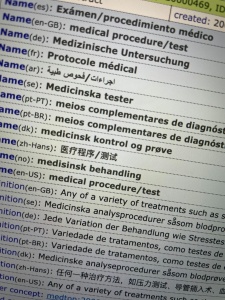 Today, IPTC announces the biggest change to the NewsCodes vocabularies in years. Almost 200 terms have been modified in the Media Topics vocabulary, including many “retirements”, trimming the CV down to exactly 1100 terms.
Today, IPTC announces the biggest change to the NewsCodes vocabularies in years. Almost 200 terms have been modified in the Media Topics vocabulary, including many “retirements”, trimming the CV down to exactly 1100 terms.
Overall, three controlled vocabularies have been updated: Content Warning, Content Production Party Role and Media Topic.
The changes to Media Topic CV are the biggest ever, with 9 new concepts, 60 retired concepts and 120 modified concepts, including 79 hierarchy moves.
The NewsCodes Working Group has been working hard on this update for over six months, bringing much-needed clarity to the “economy, business and finance” branch.
As part of the review, the “economic sector” sub-branch has been re-named “products and services”, handle both the companies making products or providing services, and also the products and services themselves.
Specifically, we have changed the following:
- 9 New concepts: business reporting and performance, business restructuring, commercial real estate, residential real estate, podcast, financial service, business service, news industry and diversity, equity and inclusion.
- 60 retired concepts: business finance, accounting and audit, analysts comment, earnings forecast, stock option, licensing agreement, aquaculture, arable farming, livestock farming, viniculture, fertiliser, health and beauty product, inorganic chemical, organic chemical, computer networking, computer security, telecommunication equipment, design and engineering, house building, land price, real estate, beverage, grocery, mail order, non-durable good, kerosene/paraffin, financial and business service, funeral parlour and crematorium, janitorial service, personal finance, personal income, personal service, printing service, wedding service, industrial component, instrument engineering, news agency, newspaper and magazine, online media industry, iron and steel, mining, non-ferrous metal, process industry, distiller and brewer, paper and packaging product, rubber product, soft drinks, textile and clothing, traffic, securities, renewable energy, stock recommendation, buy recommendation, hold recommendation, sell recommendation, hot stock, Internet of Things, capital goods, e-cigarette and commercial building. Most of these have notes attached describing which terms should be used instead of the retired ones.
- 39 name (label) changes: terrorist bombings, stock buyback corporate dividends corporate earnings, business financing, shareholder activity, executive officer, business strategy and marketing, products and services, commercial fishing, plastic, computer and telecommunications hardware, semiconductor and electronic component, software and applications, restoration, online shopping, toy and game, renewable energy, electricity, waste management, auction, consultancy, financial advisory service, personal finance and investment, shipping and postal service, media and entertainment industry, books and publishing, film industry, metal and mineral mining and refining, precious material, beverage and grocery, tobacco and nicotine, casinos and gambling, derivatives, stocks and securities, handicrafts, oil and gas, sales channel and heating and cooling.
- 81 definition changes: cyber crime, war crime, bankruptcy, stock buyback, corporate dividends, corporate earnings, business financing, shareholder activity, stock option, business governance, new product or service, patent, copyright and trademark, products and services, agriculture, commercial fishing, forestry and timber, pharmaceutical, plastic, computing and information technology, computer and telecommunications hardware, semiconductor and electronic component, software and applications, telecommunication service, wireless technology, restoration, clothing, online shopping, luxury good, retail, toy and game, energy and resource, renewable energy, diesel fuel, electricity, natural gas, waste management, water supply, accountancy and auditing, auction, banking, market research, personal finance and investment, rental service, shipping and postal service, defence equipment, heavy engineering, machine manufacturing, shipbuilding, media and entertainment industry, advertising, books and publishing, film industry, music industry, public relations, radio industry, television industry, metal and mineral mining and refining, building material, precious material, beverage and grocery, tobacco and nicotine, tourism and leisure industry, casinos and gambling, hotel and accommodation, restaurant and catering, tour operator, transport, air transport, railway transport, road transport, derivatives, stocks and securities, handicrafts, asset management, railway manufacturing, medical equipment, pet product and service, biofuel, utilities, streaming service and crowdfunding.
Currently, the name and description changes have only been made in English (both en-GB and en-US variants). Other language versions will come soon when their maintainers can make the appropriate changes to their translations.
Changes to Content Warning CV
New terms Drug Use, Fantasy Violence, Flashing Lights, Personally Identifiable Information to match standard terms used in the industry. The “Flashing Lights” term is intended to be used for flagging content that may trigger photosensitive epilepsy, a key accessibility concern by many broadcasters and a legal requirement in some countries.
Label change: Suffering to Upsetting and Disturbing to match industry usage.
Changes to Content Production Party Role CV
New term Distributor. Changed definition of Information Originator.
More information on IPTC Controlled Vocabularies
As always, the Media Topics vocabularies can be viewed in the following ways:
- In a collapsible tree view
- As a downloadable Excel spreadsheet
- On one page on the cv.iptc.org server
- In machine readable formats such as RDF/XML and Turtle using the SKOS vocabulary format. See the cv.iptc.org guidelines document for more detail.
For more information on IPTC NewsCodes in general, please see the IPTC NewsCodes Guidelines.

The IPTC Video Metadata Working Group is proud to announce the release of version 1.4 of the group’s standard, Video Metadata Hub.
See the updated properties table, updated mappings table and updated guidelines document.
All changes can be used immediately in Video Metadata Hub use cases, particularly in C2PA assertions (described in our recent post).
Version 1.4 introduces several new properties and several changes to add accessibility properties and to align it more closely with the IPTC Photo Metadata Standard:
-
Content Warning: signals to viewers such as drug references, nudity or violence, and health warnings such as flashing lights.
-
Digital Source Type: whether the content was created by a digital camera, scanned from film, or created using or with the assistance of a computer.
-
Review Rating: a third-party review such as a film’s rating on Rotten Tomatoes.
-
Workflow Rating: equivalent to the XMP rating field, a numeric scale generally used by creators to tag shots/takes/videos that are of higher quality.
-
Alt Text (Accessibility): Short text describing the video to those who cannot view it.
-
Extended Description (Accessibility): Longer description more fully describing the purpose and meaning of the video, elaborating on the information given in the Alt Text (Accessibility) property.
-
Timed Text Link: refers to an external file used for text with timing information using a standard such as WebVTT or W3C Timed Text, usually used for subtitles, closed captions or audio description
-
Date Created: modified description to align it with Photo Metadata.
-
Rating: modified description to make it more specifically about audience content classifications such as MPA ratings
-
Data Displayed on Screen: changed description.
-
Keywords: Pluralised label to match the equivalent in Photo Metadata.
-
Title: changed data type to allow multiple languages
-
Transcript: changed data type to allow multiple languages
-
Copyright Year: changed description to add “year of origin of the video”
-
Embedded Encoded Rights Expression: property label changed from “Rights and Licensing Terms (1)” to clarify and align with Photo Metadata
-
Linked Encoded Rights Expression: property label changed from “Rights and Licensing Terms (2)” to clarify and align with Photo Metadata
-
Copyright Owner: label change label from “Rights Owner” to align with Photo Metadata
-
Source (Supply Chain): Change label and XMP property to align it with Photo Metadata
-
Qualified Link with Language: used by Times Text Link, specifies an external file along with its role (eg “audio description”) and human language (eg “Spanish”)
-
“Embedded Encoded Rights Expression Structure” changed label from “Embedded Rights Expression Structure” to align with Photo Metadata
-
“Linked Encoded Rights Expression Structure” changed label from “Linked Rights Expression Structure” to align with Photo Metadata
-
Data type of “Role” in the “Entity with Role” structure was changed from URI to Text to align with Photo Metadata
The Video Metadata Hub mapping tables also include mappings to the DPP AS-11 and MovieLabs MDDF formats.
The Video Metadata Hub Generator can be used to explore the properties in the standard.
Please contact IPTC or the public Video Metadata discussion group with any questions or suggestions.
The IPTC’s flagship news exchange standard, NewsML-G2, is now updated to version 2.31. The change was approved at the IPTC Standards Committee Meeting at the IPTC Autumn Meeting 2022.
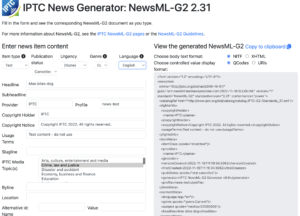
The full NewsML-G2 XML Schema, NewsML-G2 Guidelines document and NewsML-G2 specification document have all now been updated.
The only change (Change Request CR00215) is that we now allow the hasInstrument element on any concept or assert. Previously we required hasInstrument to be declared on organisations only, but we realised that not every financial instrument related to an organisation: for example an exchange-traded fund, or the instrument for a commodity, do not directly relate to a specific company.
Interestingly, hasInstrument elements in <assert>s did appear to work in previous versions, but that is because of NewsML-G2’s use of the xs:any construct which allows asserts to be augmented with arbitrary elements. No validation took place on elements which were added in this way.
Examples
Example 1: hasInstrument as a child of concept
<concept> <conceptId qcode="P:18040196349" /> <type qcode="cptType:97"/> <name>Invesco Capital Appreciation Fund;R6</name> <hasInstrument symbol="OPTFX.O" type="symType:RIC" symbolsrc="symSrc:RFT"/> <hasInstrument symbol="US00141G7328" symbolsrc="symSrc:ISO" type="symType:ISIN"/> </concept>
Example 2: hasInstrument as a child of assert
<assert qcode="P:18040196349"> <name>Invesco Capital Appreciation Fund;R6</name> <type qcode="cptType:97"/> <hasInstrument symbol="OPTFX.O" type="symType:RIC" symbolsrc="symSrc:RFT"/> <hasInstrument symbol="US00141G7328" symbolsrc="symSrc:ISO" type="symType:ISIN"/> </assert>
Example 3: hasInstrument within assert/organisationDetails
This usage still works, but is now deprecated.
<assert qcode="P:18040196349"> <name>Invesco Capital Appreciation Fund;R6</name> <type qcode="cptType:97"/> <organisationDetails> <hasInstrument symbol="OPTFX.O" type="symType:RIC" symbolsrc="symSrc:RFT"/> <hasInstrument symbol="US00141G7328" symbolsrc="symSrc:ISO" type="symType:ISIN"/> <rtr:anyOtherElement> Other elements in other namespaces allowed here due to xs:any other </rtr:anyOtherElement> </organisationDetails> </assert>
- The top-level folder of the NewsML-G2 v2.31 release is http://iptc.org/std/NewsML-G2/2.31/.
- The NewsML-G2 Implementation Guidelines document, updated to cover version 2.31 is available at https://www.iptc.org/std/NewsML-G2/guidelines
- The latest NewsML-G2 Specification document is available at https://www.iptc.org/std/NewsML-G2/specification/
- The XML Schema for NewsML-G2 v2.31 is at http://iptc.org/std/NewsML-G2/2.31/specification/NewsML-G2_2.31-spec-All-Power.xsd
XML Schema documentation of version 2.31 version is available on GitHub and at http://iptc.org/std/NewsML-G2/2.31/specification/XML-Schema-Doc-Power/.
NewsML-G2 Generator updated
The NewsML-G2 Generator has been updated to use version 2.31. There are no substantive changes but the version number of generated files has been updated to 2.31.
Thanks to Dave Compton of Refinitiv (an LSE Group Company) and the NewsML-G2 Working Group for their work on the update, and to Kelvin Holland on his work on the documentation.
To follow our work on GitHub, please see the IPTC NewsML-G2 GitHub repository.
The full NewsML-G2 change log showing the Change Requests included in each new version is available at the dev.iptc.org site.
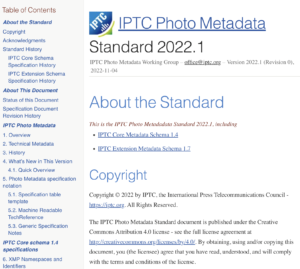 Today, the IPTC announces the release of the IPTC Photo Metadata Standard, version 2022.1.
Today, the IPTC announces the release of the IPTC Photo Metadata Standard, version 2022.1.
The update has some changes to align the IPTC Photo Metadata Standard more closely which IPTC Video Metadata Hub, which helps with the integration into the C2PA specification as announced earlier this week.
The changes will be presented today (Thursday 10 November) at the IPTC Photo Metadata Conference, alongside sessions on AI and images, C2PA, and accessibility. You can still register for today’s Photo Metadata Conference, for free, at the IPTC Photo Metadata Conference 2022 event page. Video recordings from the event will be posted in the coming weeks.
The changes in detail
The IPTC Core schema has been updated to version 1.4, including the following changes:
-
Name of property Source changed to Source (Supply Chain)
-
Property Subject Code was set to legacy state
The IPTC Extension schema has been updated to version
-
New property Contributor (matching the equivalent property in IPTC Video Metadata Hub)
-
The property structure for Product has been extended with a new property Identifier
The specification document has also been updated with some edits and additions to Help Texts and User Notes.
Technical Reference update
The IPTC Photo Metadata TechReference has also been updated to include the changes in version 2022.1. This can be used by software makers to easily include the changes in the new version.
For more information on how to use the Technical Reference, please consult the IPTC Photo Metadata Technical Reference documentation.
Questions? Comments?
For any questions or comments on this update or on the IPTC Photo Metadata Standard in general, please post to the public IPTC Photo Metadata forum at iptc-photometadata@groups.io.
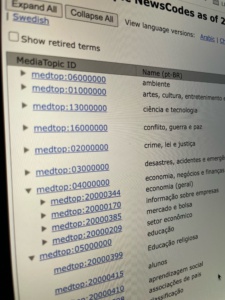
As is now traditional, the IPTC NewsCodes Working Group has released our regular update at the end of the calendar quarter.
This release includes updates to the Media Topic and Item Relation CVs.
Changes to the Media Topic vocabulary
Label and/or definition changes:
- medtop:20001304 sports award -> sports honour (definition also changed)
- medtop:20001303 sports medal -> sports medal and trophy (definition also changed)
- medtop:20001302 sports record (definition changed)
- medtop:20001104 drug use in sport (definition changed)
Retired terms:
- medtop:20001105 drug abuse in sport: RETIRED
- medtop:20001106 drug testing in sport: RETIRED
- medtop:20001107 medical drug use in sport: RETIRED
Hierarchy moves:
- medtop:20001338 education policy: moved from medtop:05000000 education to medtop:20000621 government policy. This change was suggested by ABC Australia – thanks very much!
New terms:
- medtop:20001360 fraternal and community group (child of medtop:20000768 communities)
- medtop:20001361 cyber warfare (child of medtop:16000000 conflict, war and peace)
- medtop:20001362 public transport (child of medtop:20000337 transport) – suggested by NTB Norway
- medtop:20001363 taxi and ride-hailing (child of medtop:20000337 transport)
- medtop:20001364 shared transport (child of medtop:20000337 transport)
The release also includes no-NN (New Norwegian) translations for the updates released in Q2 2022. Other languages were already updated over previous months.
Changes to other Controlled Vocabularies
The itemrelation CV is used in NewsML-G2 to show types of links between news items. The vocabulary now has two new terms:
- irel:translatedFromRoot: “The related resource contains the content from which this item was translated, either directly or indirectly via one or more other translations”
- irel:wasPackagedIn: “Indicates that this Item was included in the target package”
Thanks to everyone from IPTC members and users of the NewsCodes CV for suggesting terms, and to the NewsCodes and Sports Content Working Groups who helped to put this release together.

Following on with our quarterly update cycle, the IPTC NewsCodes Working Group has released the Q2 2022 update of IPTC NewsCodes, including updates to the Media Topic, Subject Code, and Digital Source Type vocabularies.
Media Topic updates
- Translation changes:
- A new language translation for “New Norwegian” (Norwegian nynorsk, no-NN) has been added to all labels. The existing Norwegian labels previously tagged with “no” are now tagged as “no-NB” for Norwegian bokmål. Thanks very much to NTB for providing the update.
- Label and definition changes:
- medtop:20000446 diseases and conditions
- medtop:20001230 corporate social responsibility -> environmental, social and governance policy (ESG)
- medtop:20000449 epidemic -> epidemic and pandemic
- medtop:20000451 virus disease -> viral disease
- medtop:20000452 AIDS -> HIV and AIDS
- medtop:20000457 medical conditions -> medical condition
- medtop:20000458 mental health and disorder
- medtop:20000463 health organisation
- medtop:20000464 health treatment -> health treatment and procedure
- medtop:20000466 dietary supplement
- medtop:20000467 medical drugs -> non-prescription drug
- medtop:20000468 prescription drugs -> prescription drug
- medtop:20000469 medical procedure/test -> medical test
- medtop:20000470 medicine -> health care approach
- medtop:20000474 western medicine -> conventional medicine
- medtop:20000480 government health care
- medtop:20001225 ophthalmology -> eye care
- Definition changes:
- medtop:07000000 health
- medtop:20000784 family planning
- medtop:20000454 heart disease
- medtop:20000456 injury
- medtop:20000461 health facility
- medtop:20000465 diet
- medtop:20001219 drug rehabilitation
- medtop:20001221 emergency care
- medtop:20000471 herbal medicine
- medtop:20000472 holistic medicine
- medtop:20000473 traditional Chinese medicine
- medtop:20000479 healthcare policy
- medtop:20000483 health insurance
- medtop:20000484 private health care
- medtop:20000486 medical service
- medtop:20000490 paediatrics
- Hierarchy moves:
- medtop:20000500 animal moves to become a child of medtop:20000441 nature
- medtop:20000507 flowers and plants moves to become a child of medtop:20000441 nature
- medtop:20001318 pests moves to become a child of medtop:20000500 animal
- medtop:20000494 animal disease moves to become a child of medtop:20000500 animal
- medtop:20000495 plant disease moves to become a child of medtop:20000507 flowers and plants
- medtop:20000460 obesity becomes a child of medtop:20000457 medical condition
- medtop:20000477 vaccine becomes a child of medtop:20000464 health treatment and procedure
- New terms:
- medtop:20001355 developmental disorder
- medtop:20001356 depression
- medtop:20001357 anxiety and stress
- medtop:20001358 public health
- medtop:20001359 pregnancy and childbirth
- Retired terms:
- medtop:20001218 pandemic (use the new “epidemic and pandemic” term instead)
- medtop:20000450 plague (disease)
- medtop:20000453 retrovirus
- medtop:20000455 illness
- medtop:20000475 physical fitness
- medtop:20000476 preventative medicine
- medtop:20001220 general practice
- medtop:20000488 geriatric medicine
- medtop:20000489 obstetrics/gynaecology
- medtop:20001223 oncology
- medtop:20001222 orthopaedics
- medtop:20000713 pharmacology
- medtop:20001227 psychiatry
- medtop:20001224 radiology
- medtop:20000491 reproductive medicine
- medtop:20001226 surgical medicine
- medtop:20000493 non-human diseases
In a related tool update announcement, we have now added a handy “show retired terms” checkbox to the Media Topics interactive tree browser tool, and we default to only showing the active (non-retired) terms. The new option can be seen in the picture at the top of this article.
Digital Source Type vocabulary updates
After asking for feedback on a draft of the work a few months ago, we have updated the Digital Source Type vocabulary to support the emerging area of “Synthetic Media.”
The single term “softwareImage” has been retired, which means that while it is acceptable in legacy content, we no longer recommend its use. The term is now replaced with 9 new terms covering the spectrum from purely human creation through to purely machine image creation:
- Original media with minor human edits
- Composite of captured elements
- Algorithmically-enhanced media
- Data-driven media
- Digital art
- Virtual recording
- Composite including synthetic elements
- Trained algorithmic media
- Pure algorithmic media
- RETIRED: Created by software
To see more detail including the definition of each term, click the links above or view the entire IPTC Digital Source Type vocabulary.
Thanks to those both inside and outside of the IPTC community who gave feedback on our original proposal, your comments were very much appreciated.
Subject Code vocabulary updates – indicating its deprecated status
The IPTC Subject Code vocabulary was created over twenty years ago, in the year 2000. It was maintained through to 2010, but at that point the Media Topic vocabulary took over as IPTC’s preferred subject classification taxonomy. We will keep it on our vocabulary server, but we no longer recommend its use in projects due to some terms being out of date.
So we have put warnings on the pages of the Subject Code vocabulary that indicate its deprecated nature, and encourage users to look at Media Topic instead.
As always, the Media Topics vocabularies can be viewed in the following ways:
- In a collapsible tree view
- As a downloadable Excel spreadsheet
- On one page on the cv.iptc.org server
- In machine readable formats such as RDF/XML and Turtle using the SKOS vocabulary format: see the cv.iptc.org guidelines document for more detail.
For more information on IPTC NewsCodes in general, please see the IPTC NewsCodes Guidelines.
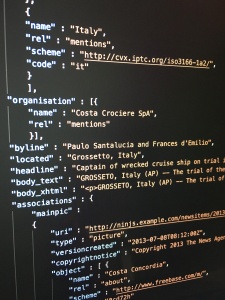 At the IPTC Spring Meeting in May 2022, IPTC’s Standards Committee voted to approve ninjs 1.4, the latest version in the 1.x track of IPTC’s standard for news content in the JSON format.
At the IPTC Spring Meeting in May 2022, IPTC’s Standards Committee voted to approve ninjs 1.4, the latest version in the 1.x track of IPTC’s standard for news content in the JSON format.
Johan Lindgren of TT Nyhetsbyrån, Lead of the IPTC News in JSON Working Group, said:
“After the launch of ninjs 2.0 in the autumn of 2021, we received requests to add some of the new 2.0 features to the first generation of ninjs, so that those who are using the 1.x branch of ninjs can use the new features without making breaking changes. So we are excited to publish version 1.4 of ninjs, where these features are included.”
Those changes include:
- New property contentcreated, denoting the date and time when the content of this ninjs object was originally created (as opposed to the date and time when the ninjs object itself was created). For example, an old photo that is now handled as a ninjs object may have a firstcreated and versioncreated of “2022-06-02T12:00:00+00:00”, but a contentcreated value of “1933-04-03T00:00:00+00:00”. The contents must be a valid JSON Schema date-time object.
- New property expires, showing “the date and time after which the Item is no longer considered editorially relevant by its provider.” Note that this is not the same as a rights-related expiration, it simply conveys the desire of the content creator to highlight the content until a certain time. A good example might be a football match preview, which would no longer be editorially relevant after the game commences. The contents must be a valid JSON Schema date-time object.
- New property rightsinfo, which holds an expression of rights to be applied to the content. It contains sub-properties langid (a URI which specifies the language used to specify rights such as RightsML or ODRL), and one of either linkedrights (containing a link to a remotely-hosted declaration of the rights associated with the content) or encodedrights (which includes an embedded encoding of the rights statements within the ninjs object).
Which version of ninjs should I choose for my project?
There might be some confusion since we have released ninjs 1.4 after the release of ninjs 2.0. Please note that this is simply an update to the 1.x branch of ninjs to make it easier for users who cannot upgrade to 2.x branch due to breaking changes.
If you are starting a new project that requires JSON-encoded news content, we recommend using ninjs 2.0. This version should be easiest for developers to work with.
If you are already using a 1.x version of ninjs, we recommend at least upgrading to version 1.4. This should be an easy change, because 1.4 is backwards-compatible with versions 1.0, 1.1, 1.2 and 1.3. We would also recommend upgrading to 2.0 if possible, but if not, 1.4 is the best version of the 1.x branch.
Supporting materials for ninjs 1.4 and ninjs 2.0 can be found at these locations:
- JSON Schema for ninjs 1.4: https://iptc.org/std/ninjs/ninjs-schema_1.4.json
- JSON Schema for ninjs 2.0: https://iptc.org/std/ninjs/ninjs-schema_2.0.json
- User Guide for ninjs (covering version 2.0 but mentioning 1.4): https://iptc.org/std/ninjs/userguide/
- The ninjs Generator has been updated to output 1.4-compatible JSON: https://www.iptc.org/std/ninjs/generator/
Thanks to Johan and the IPTC News in JSON Working Group for working on this release.
We have just released a small update to the Media Topics contr olled vocabulary for news and media content. The changes support the Winter Olympics which starts this week.
olled vocabulary for news and media content. The changes support the Winter Olympics which starts this week.
The changes are:
- The definition of bobsleigh (medtop:20000854) was changed to reflect the fact that bobsleigh now offers a one-person version (which is incidentally referred to as “monobob”). The new definition is: One, two or four people racing down a course in a sled that consists of a main hull, a frame, two axles and sets of runners. The total time of all heats in a competition is added together to determine the winner.
- Similarly, the definition of freestyle skiing (medtop:20001058) was changed to reflect new events this year. The new definition is: Skiing competitions which, in contrast to alpine skiing, incorporate acrobatic moves and jumps. Events include aerials, halfpipe, slopestyle, ski cross, moguls and big air.
We also took the opportunity to add a term which was recently suggested by ABC Australia and Fourth Estate in the US:
- tsunami (medtop:20001353), child of medtop:20000151 natural disaster – High and powerful ocean waves caused by an underwater land disturbance, such as an earthquake or volcanic eruption, known to cause significant damage and loss when they hit land
We would like to thank to all Media Topics users and maintainers for their feedback and support.